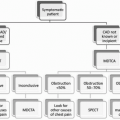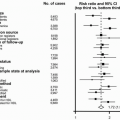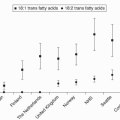Primary Prevention Trial (CPPT) (12); and the Dietary Approaches to Stop Hypertension (DASH) Trial (13). The ATP I Step I diet recommended lowering SFA to <10% of calories for the general population with further reduction to <7% of calories in the Step II diet for treatment of elevated total cholesterol when patients were nonresponsive to Step I diet. According to a meta-analysis reported in 1997 by Howell et al. (14) for every 1% change in total calories from SFA, a 1 % mg/dL change in LDL-C can be expected. Another meta-analysis conducted by Yu-Poth et al. (15) in 1999 reported results from studies of Step II diet with SFA at <7% of calories and CHOL at <200 mg/day in conjunction with weight loss. An average of 3 to 6 kg, a 16% decrease in LDL-C was reported with this combined approach. The ATP III TLC Program guidelines incorporated these results concluding that a 1% reduction in SFA would reduce serum LDL-C by approximately 2%. The major sources of SFA in the U.S. diet are fats from animal sources, primarily meat and dairy products, as well as tropical oils.
significant differences in CVD mortality among women randomized to the diet modification (DM) intervention recommending <20% of calories from TF. The primary outcome measure of the low-fat intervention was breast cancer and no cardiovascular dietary intervention was specifically advocated. The WHI DM intervention also recommended higher intakes of fruits, vegetables, and grains but the primary focus was low fat with no further focus on physical activity or weight loss. Although it was presumed that reductions in TF of that magnitude would automatically include reductions in SFA, the results suggest that focusing on TF alone is inadequate to achieve the maximal reduction of LDL-C or any improvement in HDL-C. This shows that targeted messages in dietary fat intake are needed for maximizing lipid levels. Since UFA do not raise LDL-C when substituted for carbohydrates in the diet, it is not necessary to restrict TF intake to reduce LDL-C, if SFA and TFA are reduced to goal levels. However, fat is a source of calories, which can promote obesity. Alternatively, high carbohydrate (CHO) intake at the level ≥60% of calories can also aggravate lipid and nonlipid risk factors associated with the metabolic syndrome. The TLC Program recommends that TF intakes should range from 25% to 35% of calories but those individuals at risk of the metabolic syndrome should aim at 30% to 35% of total calories with an emphasis on a higher ω-3 to ω-6 ratio and including a higher intake of MUFA than recommended for the general population. Since dietary fat, especially SFA and TFA, has such a major effect on lipid levels, guidelines on interpreting fat intake are provided in Table 19.1.
TABLE 19.1 FAT INTAKE GUIDELINES | |||||||||||||||||||||||||||||||||||||||||||||||||||
|---|---|---|---|---|---|---|---|---|---|---|---|---|---|---|---|---|---|---|---|---|---|---|---|---|---|---|---|---|---|---|---|---|---|---|---|---|---|---|---|---|---|---|---|---|---|---|---|---|---|---|---|
|
Stay updated, free articles. Join our Telegram channel

Full access? Get Clinical Tree








